Build-A-Rig Round 2, SilverStone vs. Crucial: The $800 PC Showdown
by Daniel Williams on November 12, 2015 8:00 AM EST- Posted in
- Build-A-Rig
- Systems
- Crucial
- SilverStone
Power, Temperature, and Noise
Some may not be too worried about power and noise, especially students who may be aren't paying a power bill at their dorm or their parents’ house. Still, the more power a computer draws the more heat it has to deal with and the more cooling required, and that in turn makes it harder to keep noise levels low. This problem is made worse in smaller builds where there isn't room for a large cooler with plenty of surface area. So in the end one way or the other all three of the areas covered here will have an impact on one's experience.
One quick note here: for the Mighty Milo I’m using the silent fan profile for the stock performance – with the aftermarket cooler even silent is plenty – and when overclocked I’m using the higher speed performance fan profile.
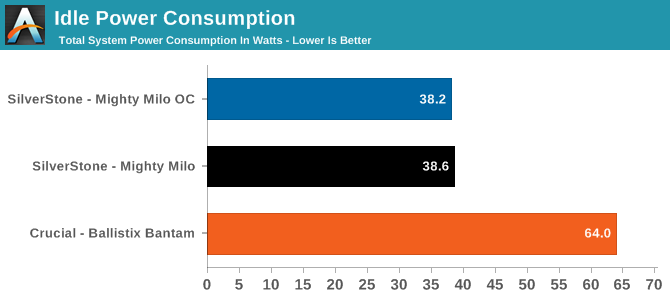
Out of the gate, we find a surprising difference in idle power consumption between the two systems. SilverStone’s build idles with much less power consumption than the Crucial build. Since we’re looking at complete systems it’s not immediately clear what the difference is, but as the Thermaltake PSU in the Crucial build is a larger 600W unit that is not 80Plus rated, it’s likely that the PSU is greatest factor here.
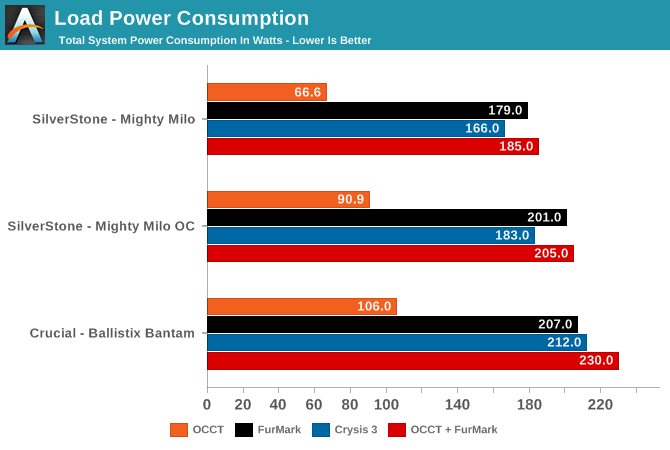
Shifting over to load power consumption the story hasn’t changed much. The Crucial system draws more power at every stage, this despite the fact that it’s the SilverStone system with the more power-hungry video card. Even overclocked, Mighty Milo still draws less power than the Ballistix Bantam, though I suspect in practice Milo is actively using more power. This once more points to the PSU and energy conversion losses being the biggest contributor here.
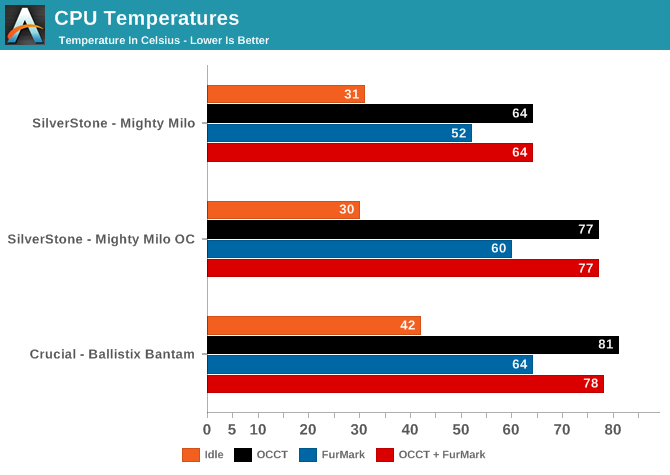
Moving on to temperatures, it’s the Mighty Milo that has the edge with CPU temperatures. With its larger, non-reference cooler and lower rated wattage of the Pentium CPU, this was its metric to win, even with the silent fan profile. Otherwise I suspect that the cases are playing a role here as well, though certainly not as much as the coolers.
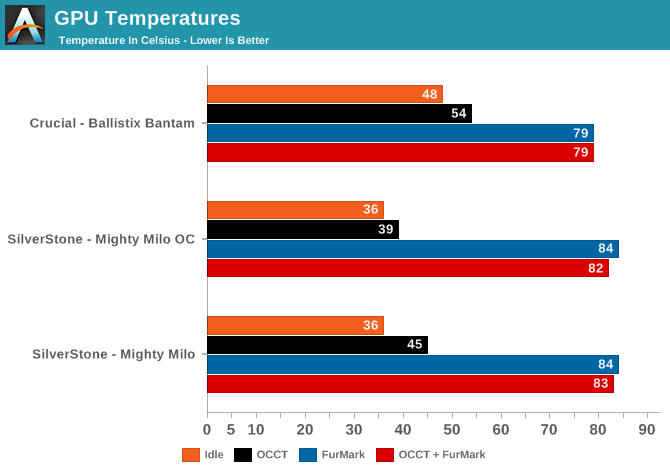
With GPU temperatures on the other hand it’s the Ballistix Bantam in the top spot. The GTX 950 is innately a cooler running video card, and that makes everything easier when it comes to keeping down temperatures. Though it’s interesting that at idle this build is quite a bit warmer than the Mighty Milo, which may be the cooler on the card or it may be the case.
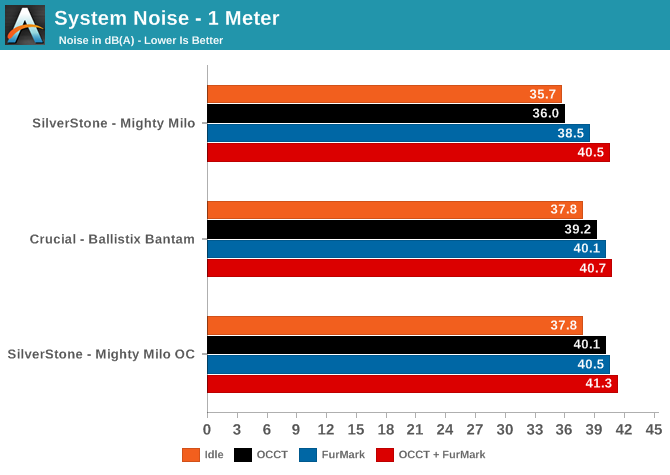
Finally, with system noise, both systems produce similar results. The Mighty Milo has the overall edge, particularly when stressing just the CPU or GPU. Otherwise when both processors are under full load, the gap between the two systems is just 0.8dB. I have to say a number I loved seeing during testing was the OCCT (CPU) load noise for the Mighty Milo at stock speeds on the silent profile. With a measurement of less than one decibel above idle, the volume under load is indiscernible from the volume at idle. In day to day life in anything less than a very quiet environment, it wouldn't be hard for a machine such as this to be rendered inaudible except when the GPU really kicks in.










43 Comments
View All Comments
nathanddrews - Thursday, November 12, 2015 - link
But... but...https://youtu.be/9gSQg1i_q2g
shmuck - Thursday, November 12, 2015 - link
Damn straight! Somebody's got to do the complaining around here. Harumph.https://www.youtube.com/watch?feature=player_detai...
The privacy information which was missing from the link:
https://www.surveygizmo.com/privacy/
This is a lot more encouraging.
eanazag - Tuesday, November 17, 2015 - link
My only gripe about the contest is it is closed too fast. It seems like you have less than 24 hours to enter it. The first one was confusing because Anandtech used to just place a post on the article and you were "entered". I think I have it figured out now. We just need a few more of these for me to enter.I understand the marketing hope on having it end so quickly. I typically read all the headlines when they're released and then read the articles later.
BrokenCrayons - Thursday, November 12, 2015 - link
Even after benchmarking, I still find it very difficult to favor one system over the other. They're both very solid builds without any show stopping flaws. Either system would serve a college student well in a variety of computing tasks. As usual, I love reading these build-a-rig articles.Samus - Thursday, November 12, 2015 - link
Damn that Silverstone is a sexy beast. Throw in i5-4690k in there and damn...racerx_is_alive - Thursday, November 12, 2015 - link
The only problem with spreading these articles out they way they are is that I'm only 75% sure I signed up for the sweepstakes with the first article, but don't want to do it again and get my entry tossed. But otherwise, I really like the way this series is organized, and the computers they've built.smorebuds - Thursday, November 12, 2015 - link
"IF YOU ENTER MORE THAN ONCE, ALL BUT ONE ENTRY WILL BE DELETED."Sounds like you'll still have an entry in there.
Ryan Smith - Thursday, November 12, 2015 - link
Humm, interesting. I hadn't considered that angle before. Thanks for the feedback.ShieTar - Thursday, November 12, 2015 - link
Nice, but am I the only one that feels that more fun should be poked at the 600W-PSU in the 200W-PC?Just shows that even when somebody knows what they are doing in general, they will always remain capable of messing up on some important detail.
BrokenCrayons - Thursday, November 12, 2015 - link
The 600 watt PSU is excessive for the computer's current hardware, but it might be worth considering the extra wattage as headroom to grow into a more powerful CPU and/or graphics card later without being concerned about wattage. The Core i3-4170 is a 54 watt TDP processor and the GTX 950 is a 90 watt card. Moving up to a GTX 980 would add 75 watts more demand (165 watts total power according to NV's site) and an i7-4770 would need another 30 watts (84 watt TDP). That'd quickly turn the 200+ watt PC into a 300+ watt one which puts the PSU at 50% load which is well into the more efficient areas of its power delivery curve.